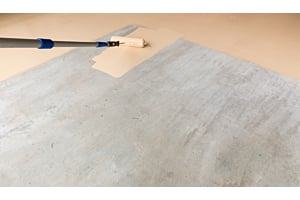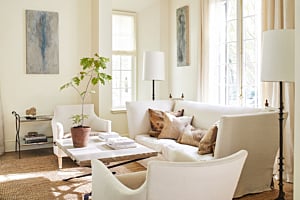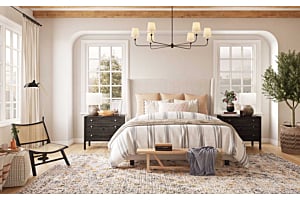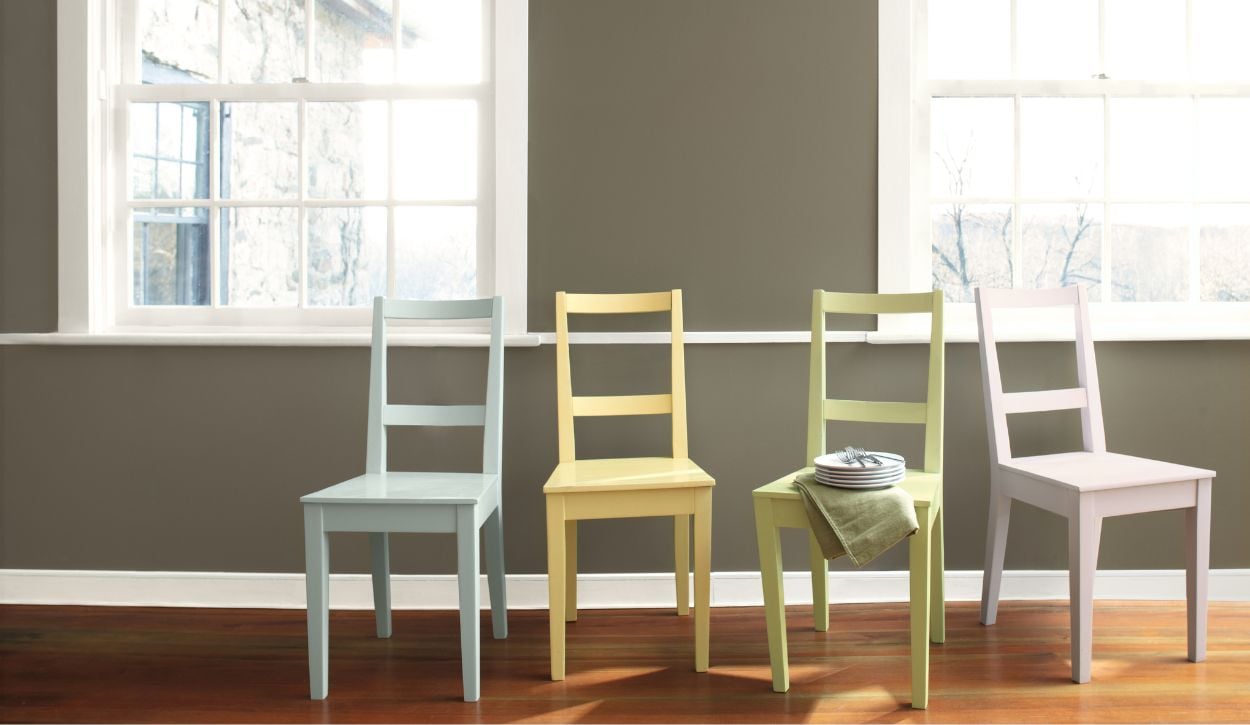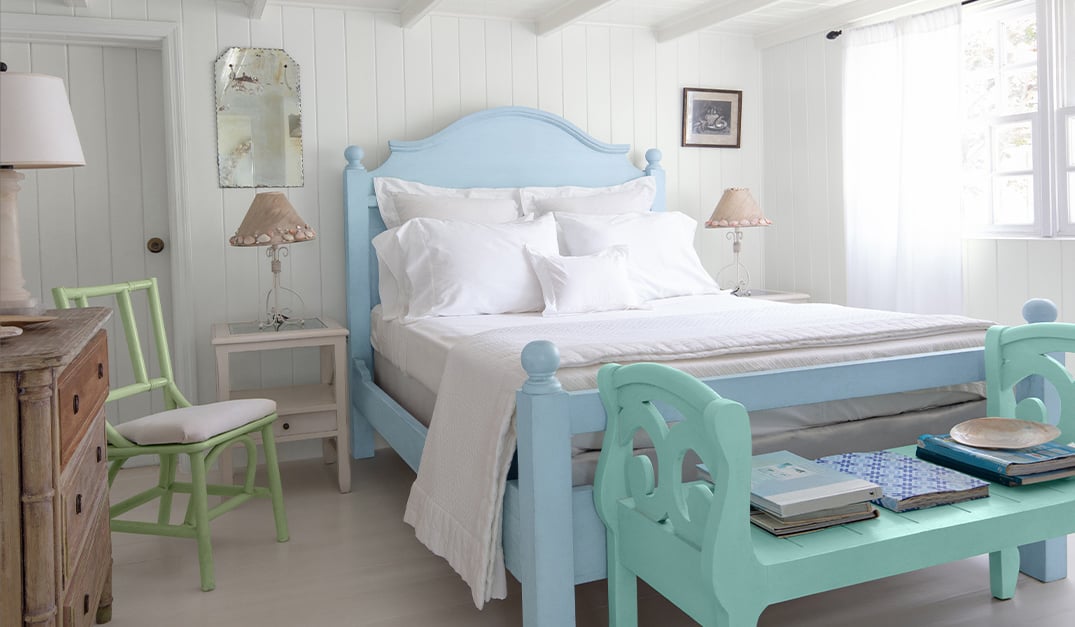
Furniture makeovers are one of the most popular DIY projects, and a quality paint job is key to a great furniture transformation. Painting furniture is easier than completely refinishing and offers more opportunities to be creative. Whether you're giving new life to a vintage find or customizing new furniture, choosing the best type of paint is essential for a durable and attractive finish. Read on for the pros and cons of different types of paint, and find out what really is the best paint for your furniture project.
How is furniture paint different from wall paint?
Furniture gets far more wear and tear than walls, so the surface needs to be very durable. Standard wall paint in general finishes like eggshell will not be durable enough. When furniture is in daily use, furniture paint should be moisture-resistant and cleanable to protect it from spilled drinks and fingerprints. Glossy paint finishes like satin, semi-gloss and high-gloss form a harder surface and are easier to wipe down.
Because of its no-chip finish, we believe Benjamin Moore ADVANCE Waterborne Alkyd Paint is the best furniture paint on the market. With the right paint formula and a little creativity, you can transform your furniture into stunning statement pieces that reflect your individual style!
The Best Furniture Paint: Benjamin Moore ADVANCE
Originally created for kitchen cabinets, ADVANCE waterborne alkyd paint by Benjamin Moore makes an excellent furniture paint because it’s durable, washable, and easy to touch up. This high-quality paint combines the benefits of oil and water-based paints in a formula that’s safe for your family. ADVANCE is available in high-gloss, semi-gloss, and satin finishes.
Ring’s End carries Benjamin Moore ADVANCE paints in-store and online, conveniently shipping anywhere in the U.S. For more helpful tips on selecting paint products, check out our Interior Paint Guide. Our paint professionals are ready and waiting to answer any questions you have about your paint project. Chat with us online, or text us at (203) PRO-HELP.
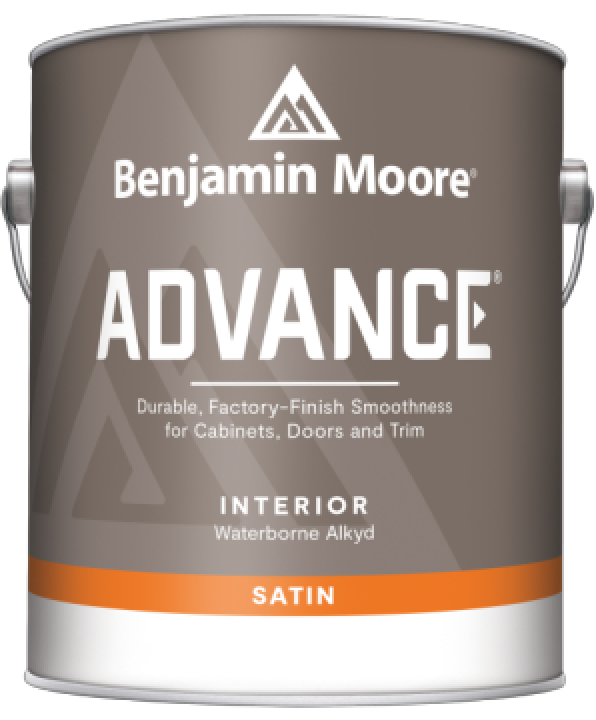
Benjamin Moore ADVANCE
Grade: Premium
Finishes: Satin, Semi-Gloss, High-Gloss
Formula Type: Waterborne alkyd enamel
Colors: 3,500+
Here are a few more reasons we think ADVANCE will become your favorite furniture paint.
Hides Brush Strokes
ADVANCE paint makes it easier to paint furniture without leaving brushstrokes. Because it has a long dry time (16 hours to recoat), ADVANCE levels exceptionally well — which means it flows into small crevices to create a smooth surface. This superior leveling ability makes it easy to create a professional-grade furniture finish. You can apply ADVANCE paint with a brush, roller, or paint sprayer.
Rich and Lasting Color
ADVANCE paint contains a higher quantity of volume solids than many competitor brands — between 37% and 40%. This means that it has more binders and pigments to provide better coverage and hide surface imperfections. This adds to the product’s durability and provides richer, more vibrant colors.
Stain-Blocking Coverage
ADVANCE paint’s stain-blocking technology easily covers blemishes on old furniture. Just prepare your furniture by cleaning, sanding, and then priming before painting. For the best coverage, use ADVANCE as a topcoat over Fresh Start High-Hiding All-Purpose Primer, which seals stains that are hard to cover.
Other Furniture Paint Recommendations
Another high-quality enamel paint that will add a beautiful and durable coating to your furniture is Fine Paints of Europe's Hollandlac/Sign Enamel or Eco paint lines. Both products are available in Satin or Brilliant (Extremely High Gloss) finishes. FPE has specific primers for each topcoat too. FPE Hollandlac/Sign Enamel is an alkyd paint with a 24-hour recoat time. FPE Eco is a water-based alkyd like Benjamin Moore's ADVANCE.
While these are high-quality coating options, they do come with long dry times. If you are looking for a paint that is faster drying and self-priming, Milk Paint is a great option. General Finishes Water-Based Milk Paint is durable and quick-drying paint. This product allows you to quickly refresh old-looking furniture into something new and exciting. General Finishes Milk Paint is available in a classic Low Lustre finish and a variety of popular colors.
Pros:
Easy to Apply
Primer not always required
Chalky, matte aesthetic
Easy to create distressed look
Cons:
Requires top coat
Easily damaged and scuffed
Limited color selection
Cannot be sprayed
Chalk paint has become popular for DIY furniture painting projects because of its thick coverage. You’ve probably seen it at the local hardware store in liquid or powder form. This kind of paint is popular for home decor and upcycling projects because it requires less prep work and has a fast dry time. It can’t be sprayed on, so you’ll need to use a roller or paint brush, which may leave brush marks. Adding chalk to the paint makes it far less durable. Chalk paint sands off so quickly that a distressed, heirloom look is easy to achieve, and sandpaper quickly removes drips. For a chalk-painting project to last, it needs a top coat of durable polyurethane sealer. This adds a second coat to the process, so chalk paint isn’t necessarily the time-saver it appears to be.
If you want your piece of furniture to have the chalky look of vintage milk paint, chalk paint is simple to use. Just remember it won’t create a durable finish; even mild wear (like taking a book off a shelf) will damage the surface over time. Chalk paint is only available in limited paint colors and a matte finish. It’s not suitable for outdoor furniture or table tops.
Latex Paint
Pros:
Quick drying
Wipable finishes
Wide color selection
Soap and water cleanup
Cons:
Requires multiple coats
Interior use only
Must use a specialty primer coat
Less durable than alkyd paints
Latex paint, also known as water-based paint, is a popular choice for furniture painting. It’s available in thousands of colors, dries quickly to a smooth finish and cleans up easily with soap and water. You’ll find latex paints in satin, semi-gloss and high-gloss finishes. These glossy sheens can be wiped down more easily and resist staining much better than a flat finish. Latex spray paint makes painting a piece of furniture faster and easier while eliminating brush strokes.
However, when using latex paint on furniture, it’s crucial to prepare the surface first. Sand the entire piece thoroughly to de-gloss the old finish and apply a primer that’s designed for latex paint. This step improves the paint’s adhesion to the surface, which helps to prevent chipping or peeling over time. For the most durable paint job, follow the primer with two coats of paint. If you want to use latex paint for furniture, choose a formula that’s intended for high-wear surfaces like cabinetry and trim.
Oil-Based Paint
Pros:
Very durable once fully cured
Hides brush marks
Cons:
Requires multiple coats
Strong fumes pollute indoor air
Colors can yellow over time
Solvents required for cleanup
For centuries, oil-based paint was considered the best paint for furniture because of its exceptional durability and smooth finish. Superior leveling makes it easy to avoid brush marks, and it cures to a hard surface. However, oil paint is a highly polluting product; it has strong fumes and continues to off-gas chemicals known as VOCs (volatile organic compounds) into the home even after it dries. It also requires flammable solvents for clean up. Over the past few decades oil paints fell out of favor as latex paint became more durable, and new alkyd paint formulas offer the same performance in a much safer, non-VOC product. Today there is no reason to use oil-based paints in a residential setting.
Solid Wood Stain
Pros:
Durable finish
Protects against moisture
Covers in 1-2 coats
Latex formulas clean up with water
Cons:
Exterior use only
Must be brushed on
If you’re painting outdoor furniture, it’s important to have extra protection from the weather. A solid wood stain resembles a painted finish but has the added protection of a stain. While paint sits on the surface, wood stain penetrates deep to create a durable finish that resists moisture and protects against mildew, peeling, and stains. Benjamin Moore’s Woodluxe Solid Stain is ideal for painting outdoor furniture. It has excellent color retention and is available in all 3,500+ Benjamin Moore paint colors.
Alkyd Paint
Pros:
As durable as oil paint
Will not yellow over time
Hide brush strokes
Very low odor, no harmful VOCs
Soap and water cleanup
Cons:
Interior use only
Costs more than latex paint
Alkyd paint is engineered to perform like an oil-based paint, but with lower VOCs and easier cleanup. Plus, it won't yellow over time the way oil does. Like oil paint, alkyd paint has an extended open time (the period in which imperfections on a fresh coat of paint can be fixed).
Once it is cured, alkyd paint creates a hard, water-resistant finish that’s durable enough for living room furniture.
Benjamin Moore ADVANCE paint is a water-based alkyd enamel — and our paint experts' top choice for wood furniture because of its easy application, superior coverage, and smooth finish. We're confident you'll love this product for your next interior design project!



